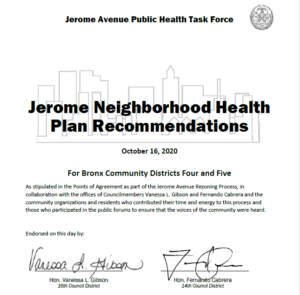By Taisy Conk, Program Director
Bronx residents and champions have a new resource to back up their demands when advocating for investment in the borough. The Jerome Avenue Public Health Taskforce spent 2019 building relationships, engaging the community, and forming recommendations to address the underlying social structures that have given rise to unacceptable health inequities in the Bronx and communities like it. The Task Force, which was facilitated by the New York City Health Department, consisted of community members and staff from neighborhood institutions, including New Settlement and Community Food Action Last year we shared what we heard during a Town Hall as a part of that process. Now, the Jerome Neighborhood Health Plan Recommendations are final and endorsed by City Council Members Cabrera and Gibson.
The recommendations are organized into six domains: education, public outdoor spaces, healthcare quality and access, food environment, housing and local economic development. Within the goal to increase access to healthy, affordable, culturally appropriate food, recommendations include expanding farmers markets, launching a food policy council, retail improvements, and school food. Although drafted before the COVID-19 pandemic, we firmly believe these recommendations are as crucial as ever for a healthy and livable Bronx.
Gus Stavroulakis, community member, Task Force Member, and Community Food Action’s Youth and Farm Stand Coordinator, put it best in an article on the Plan. “When a person goes to the doctor or to the hospital, that is only a measurement of that person’s health. Those measurements are a story of how a person lived and how society has treated them. These Task Force health recommendations, which include many parts of a person’s life, are essential to improve health.”
The Task Force envisions that these recommendations will become realized as elected officials, community leaders, community members, and other stakeholders remain activated and interested in working to implement the recommendations and related policies and practices. Also key will be to ensure appropriate funding streams. We expect that these recommendations align with those already in motion by activists in the Bronx and beyond. We hope to join forces and to work to enact these to ensure that the identity of the Southwest Bronx is maintained at the same time as we aim to improve quality of life for residents.
